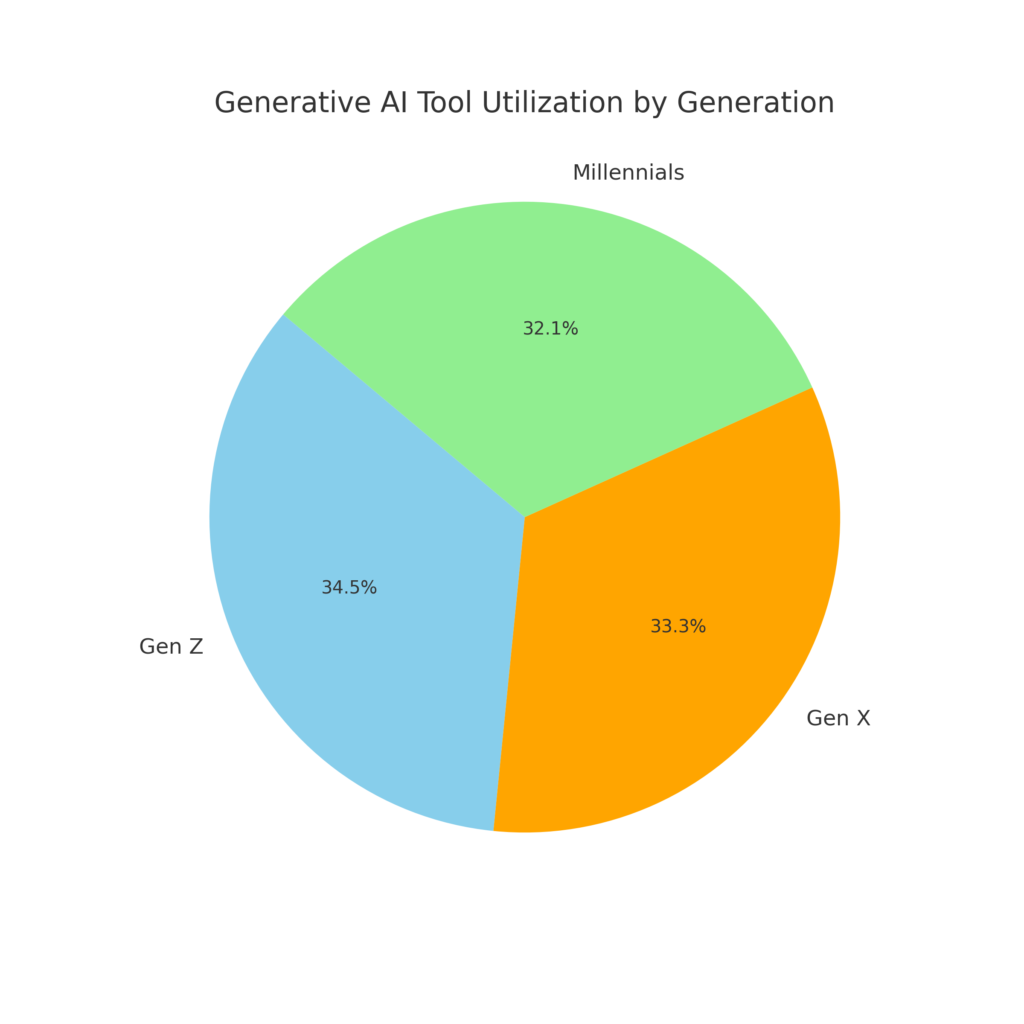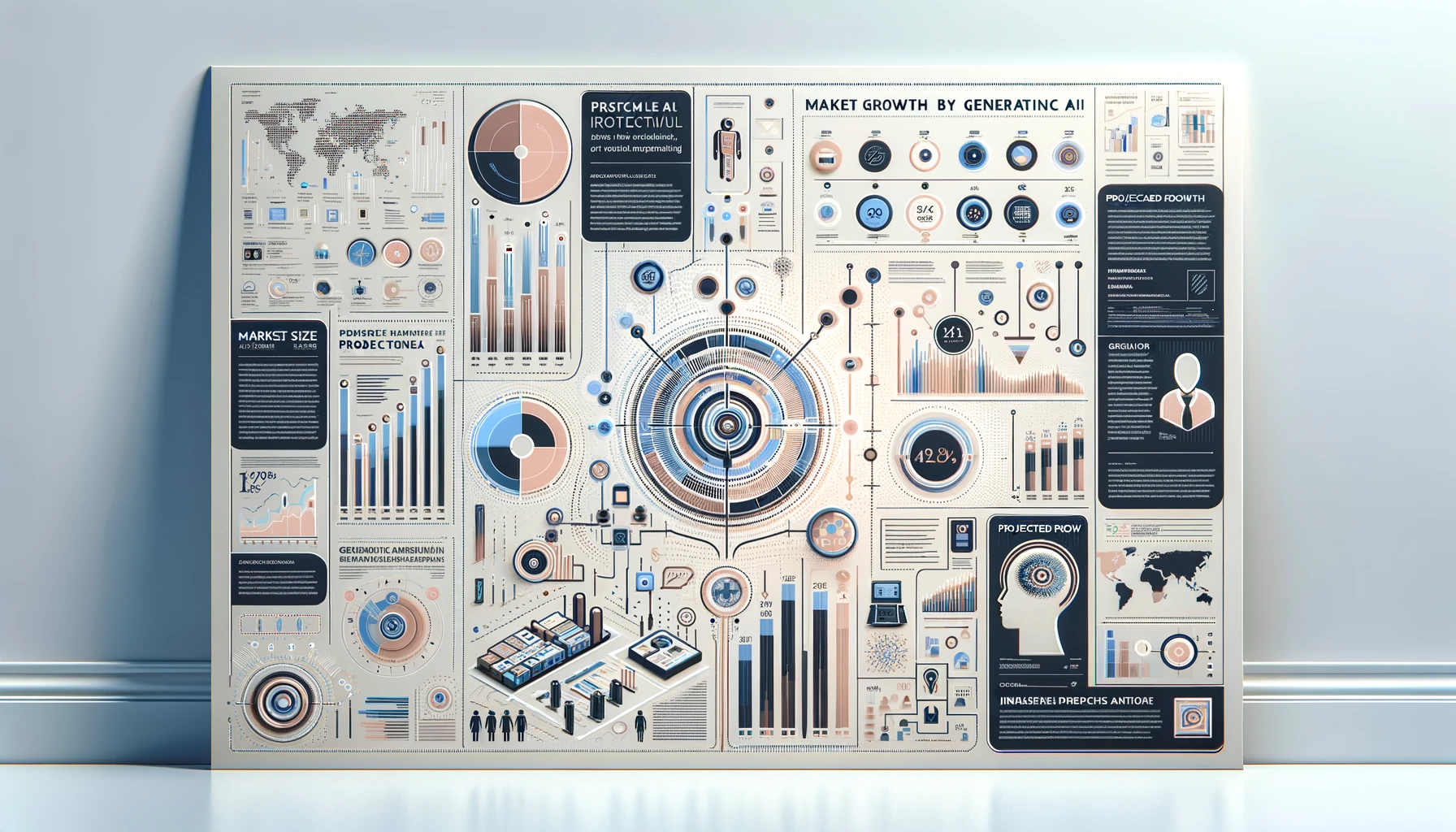Did you know that the generative AI market is projected to exceed $22 billion by 2025?
The field of generative AI is revolutionizing the artificial intelligence market, leveraging deep learning, machine learning, natural language processing, neural networks, and computer vision to create new and original content. Generative algorithms enable algorithmic generation, transforming the way we perceive and interact with technology.
From generating realistic images to creating human-like text, generative AI is making significant strides in various industries, including advertising, healthcare, and technology. It has the potential to streamline content creation processes, enhance user experiences, and unlock novel possibilities in problem-solving.
In this article, we will delve into the generative AI market’s size, growth projections, adoption across industries, funding landscape, key players, and market segments. So, let’s explore the exciting world of generative AI and discover the trends shaping its future growth.
Table of Contents
Generative AI Industry Highlights
| Generative AI Market Value (2022) | Generative AI Market Value Projection (2025) | Compound Annual Growth Rate (CAGR) |
|---|---|---|
| $13 billion | $22 billion | 27.02% |
The North American generative AI market holds a 41% revenue share.
Transformer models accounted for 42% of generative AI revenues in 2022.

Understanding the Generative AI Market Size

As the generative AI market continues to expand, it is crucial to comprehend its size, valuation, expansion drivers, and regional market share insights. By examining these factors, businesses and stakeholders can make informed decisions and seize opportunities in this thriving industry.
Current Market Valuation
The generative AI market is currently estimated to be worth $13.71 billion, highlighting its substantial presence and potential for growth. This valuation reflects the market’s increasing adoption rates, aided by tools like ChatGPT, and the advancements in machine learning that enable the creation of innovative and original content.
Key Factors Driving Market Expansion
The generative AI market has experienced significant expansion due to several crucial factors. One of these is the explosion of digital data availability, which provides an abundant source of information for generative algorithms to learn from and generate new content. Additionally, the advancements in machine learning techniques have further fueled the market’s growth, enabling AI models to better understand and generate high-quality output.
Regional Market Share Insights
When analyzing the regional market share within the generative AI industry, North America emerges as a dominant player, holding the largest revenue share of 41%. This can be attributed to the region’s technological advancements, supportive ecosystem, and high adoption rates. Other regions, such as Europe and Asia-Pacific, also contribute significantly to the market, with their own unique dynamics and growth opportunities.
Generative AI Market Growth Projections
The generative AI market is projected to reach $22.12 billion by 2025, growing at a compound annual growth rate (CAGR) of 27.02%. The market’s growth trajectory is expected to be exponential, with valuations increasing from $10.79 billion in 2022 to $118.06 billion by 2032. These growth projections highlight the promising future of the generative AI market and its potential impact on various industries.

The generative AI industry is witnessing rapid expansion, driven by advancements in artificial intelligence technology. As businesses across sectors recognize the immense potential of generative AI, the market is expected to experience substantial growth in the coming years. With a projected CAGR of 27.02%, the market is set to double in value within the next five years, reaching $22.12 billion.
This exponential growth can be attributed to several factors. Firstly, the rise in adoption of generative AI tools and techniques across industries is fueling market demand. From generating realistic images to producing creative written content, generative AI algorithms are transforming the way businesses operate and innovate.
Additionally, the increasing availability of large-scale datasets and advancements in machine learning are driving the growth of generative AI. These technologies empower AI models to learn from vast amounts of data and generate outputs that closely resemble human-created content.
The projected market value of $22.12 billion reflects the increasing adoption of generative AI and its potential impact on industries such as advertising, design, entertainment, and healthcare. As businesses strive to enhance their creativity, improve productivity, and create personalized customer experiences, generative AI is poised to play a pivotal role.
Looking ahead, the generative AI market is expected to continue its upward trajectory, with valuations surpassing $100 billion by 2032. As technology continues to advance and AI algorithms become more sophisticated, the generative AI market will offer further opportunities for industry players, startups, and investors alike.
Adoption of Generative AI in Various Industries
Generative AI tools have already made significant inroads into various industries, revolutionizing the way they operate. A survey conducted to gauge AI tool utilization across different generations revealed interesting insights. Among Gen Z, 29% reported using generative AI tools in their workplaces, followed closely by 28% of Gen X and 27% of Millennials. This indicates a growing acceptance and integration of generative AI technology across the board.

Several industries have experienced notable disruptions and transformation through the adoption of generative AI. Advertising and marketing have harnessed the power of generative AI to create more personalized and targeted campaigns. The technology industry has embraced generative AI to augment and streamline various processes, unlocking new possibilities for innovation. Consulting firms leverage generative AI to analyze and derive valuable insights from vast amounts of data. Even traditional sectors such as accounting and healthcare have integrated generative AI to enhance efficiency and decision-making.
Looking ahead, forecasts indicate that large-scale adoption of generative AI is poised to reach 46% by 2025. This projection underlines the extensive application and potential impact of generative AI across industries. As organizations continue to recognize the value and advantages offered by generative AI, it is anticipated that the adoption rate will rise exponentially.
Generational Differences in AI Tool Utilization
The utilization of generative AI tools exhibits variations among different generations. Understanding these differences can provide valuable insights into the evolving landscape of AI adoption. The survey highlighted that Gen Z, known for their digital fluency and comfort with emerging technologies, demonstrates the highest adoption rate of generative AI tools in the workplace.
Top Industries Integrating Generative AI
Generative AI has permeated various industries, revolutionizing the way they operate and deliver value. The following industries have witnessed substantial integration of generative AI:
- Advertising and Marketing: Generative AI tools enable the creation of highly personalized and targeted campaigns, allowing businesses to connect with their audiences more effectively.
- Technology: The technology industry has embraced generative AI to enhance automation, improve process efficiency, and drive innovation.
- Consulting: Generative AI aids consulting firms in analyzing vast amounts of data, extracting valuable insights, and providing strategic recommendations to clients.
- Accounting: The integration of generative AI streamlines accounting processes, minimizing errors, improving audit accuracy, and optimizing financial management.
- Healthcare: In the healthcare sector, generative AI is leveraged to advance medical research, improve diagnostic accuracy, and enhance patient care.
Forecasts for Large-Scale Generative AI Adoption
The future of generative AI adoption looks promising, with forecasts indicating a significant increase in large-scale adoption. By 2025, it is projected that 46% of industries will have fully integrated generative AI into their operations. This forecast highlights the growing recognition of generative AI’s potential and its ability to drive transformative change across sectors.
| Industry | Benefits of Generative AI Integration |
|---|---|
| Advertising and Marketing | Enhanced personalization, targeted campaigns, improved customer engagement |
| Technology | Automation, process efficiency improvements, innovation catalyst |
| Consulting | Data analysis, insights generation, strategic decision-making support |
| Accounting | Error reduction, audit accuracy enhancement, financial management optimization |
| Healthcare | Medical research advancements, diagnostic accuracy improvements, enhanced patient care |
Generative AI Funding and Startup Landscape

Generative AI is not only a rapidly growing market but also an attractive sector for investors. Startups in the generative AI space have successfully secured substantial funding, reflecting the confidence and potential seen in this emerging technology. This section provides an overview of generative AI funding, investment trends, and notable unicorn startups in the industry.
2022 Funding Overview
In 2022, generative AI startups raised an impressive $2.6 billion across 110 deals, indicating the high demand for funding in this sector. These investments have fueled research and development efforts, driving innovation and advancements in generative AI technologies.
Q1 2023 Generative AI Investment Trends
The investment momentum in generative AI continued in the first quarter of 2023, with startups securing $1.7 billion across 46 deals. Additionally, there were announcements for deals worth an estimated $10.68 billion that were not completed during the quarter, indicating a robust pipeline of potential funding in the future.
Unicorn Startups in the Generative AI Space
Thirteen generative AI startups have achieved unicorn status, surpassing a valuation of $1 billion. These companies have demonstrated their potential and innovation in the market, attracting substantial investments. Among them, OpenAI stands out as the highest-valued generative AI startup, with a valuation of $29 billion.
| Generative AI Unicorn Startup | Valuation (in billions) |
|---|---|
| OpenAI | $29 |
The presence of these unicorn startups showcases the immense financial opportunities available in the generative AI market. These companies are driving innovation, shaping the future of generative AI, and attracting attention from investors seeking promising ventures in this technology-driven landscape.
Exploring Key Segments in the Generative AI Market
The generative AI market encompasses various key segments that shape the industry landscape. This section explores the dominance and growth of transformer models, the market impact of diffusion networks, and the distinction between software and service offerings within generative AI.
Dominance and Growth of Transformer Models
Transformer models currently play a dominant role in the generative AI market, accounting for over 42% of the revenue. Their ability to generate high-quality content and handle complex tasks, such as natural language processing and image recognition, has made them indispensable in various applications. With continuous advancements in transformer architecture and training methods, these models are expected to continue their growth trajectory, driving innovation and expanding their market share.
Rising Stars: Diffusion Networks’ Market Impact
Diffusion networks have emerged as rising stars in the generative AI market, with their market impact growing at a rapid pace. These networks excel in modeling high-dimensional data and have shown promise in generating realistic and diverse content across multiple domains. With a remarkable compound annual growth rate (CAGR) of 37.2%, diffusion networks are gaining attention for their potential applications in areas such as image synthesis, video generation, and even drug discovery. As research and development efforts continue to enhance the capabilities of diffusion networks, their market impact is poised to grow even further.
Software Versus Service in Generative AI
The generative AI market is divided between software and service offerings, each catering to different user needs and preferences. Currently, software holds a larger market share, accounting for 65.50% of the market in 2022. Software solutions provide users with the flexibility to implement generative AI algorithms and models within their existing infrastructure, empowering them to customize and control the generation process. On the other hand, generative AI services offer a convenient and accessible option for users without extensive AI expertise, providing a cloud-based platform or API for generating content. Although software currently dominates the market, the service sector is expected to grow at a faster CAGR of 36.5%, indicating rising demand for accessible and user-friendly generative AI solutions.
Conclusion
The generative AI industry is witnessing unprecedented growth and has become one of the fastest-growing markets. With advancements in machine learning and increased adoption across industries, generative AI is driving faster content creation and opening up new opportunities for businesses and technology enthusiasts alike.
By staying updated on industry trends and understanding market dynamics, stakeholders can position themselves for success in this evolving landscape. The projected market valuation of $22.12 billion by 2025 further emphasizes the significant growth potential of the generative AI market. The promising growth projections highlight the immense value this industry holds and the transformative impact it can have across various sectors.
As generative AI continues to evolve, businesses and individuals need to embrace the possibilities it offers. Whether it’s leveraging generative AI tools for innovative content creation or exploring new market segments, staying at the forefront of the generative AI industry will be essential for sustainable growth and staying ahead of the competition.
For more relative content check out: Referral Marketing Saas, Saas Industry Growth, Social Proof Stats, ChatGpt User Statistics, Event Marketing Statistics and Artificial Intelligence Statistics.
Source: Precedence Research, Market.Us, PitchBook





